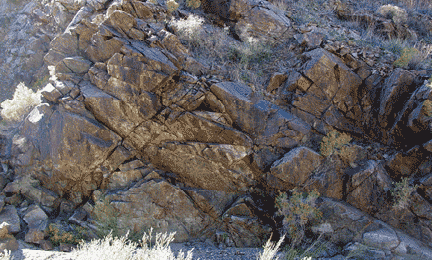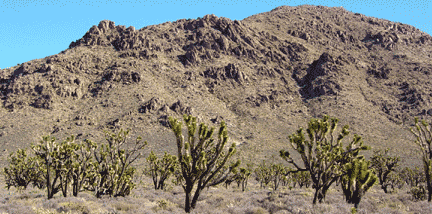Introduction to the
Mojave National Preserve
General Mojave
Geologic History
Changing Climates
& Ancient Lakes
Granitic Rocks and Associated Landforms
Weathering and erosion in arid regions underlain by granitic bedrock produce unique characteristic landforms. Spheroidal weathering is a form of chemical weathering in which concentric shells of decayed rock (ranging from a few millimeters to a couple meters) are successively loosened and separated from a block of rock. In the subsurface, groundwater penetrates along fractures and causes the chemical breakdown of rock along surfaces. Sharp corners at the intersection of fractures tend to break down first. In this manner, blocks of granitic bedrock (or other rocks that do not have layers or bedding) tend to become rounder as weathering proceeds. In humid regions, spheroidal weathering of granite typically occurs in the subsurface. In contrast, in arid regions the rate of chemical weathering is slow relative to the rate of surface erosion. As a result, in granitic terrains knob-shaped outcrops and spheroidal blocks accumulate on the surface. In the Mojave region, granite typically breaks down to form fairly uniform quartz- and feldspar-rich, coarse-sandy sediment compared to other rock types. In addition, many of the major pediment areas in the Mojave National Preserve have granitic bedrock. This is probably directly related to the more-or-less uninform weathering and erosion characteristics of large, homogeneous granitic intrustions.
 |
| Fractured granite bedrock is exposed along Globe Wash in the Providence Mountains. |
 |
| The characteristic rounded boulders and knob-shaped outcrops throughout the Granite Mountains formed as a result of spheroidal weathering and erosion of fractured granite. |
 |
| Large granitic intrusions of Cretaceous age are the bedrock of Kessler Peak in the southern Ivanpah Mountains. A Joshua-tree forest blankets a pediment surface in the foreground. This view is along Cima Road east of the Teutonia Mine area. |

